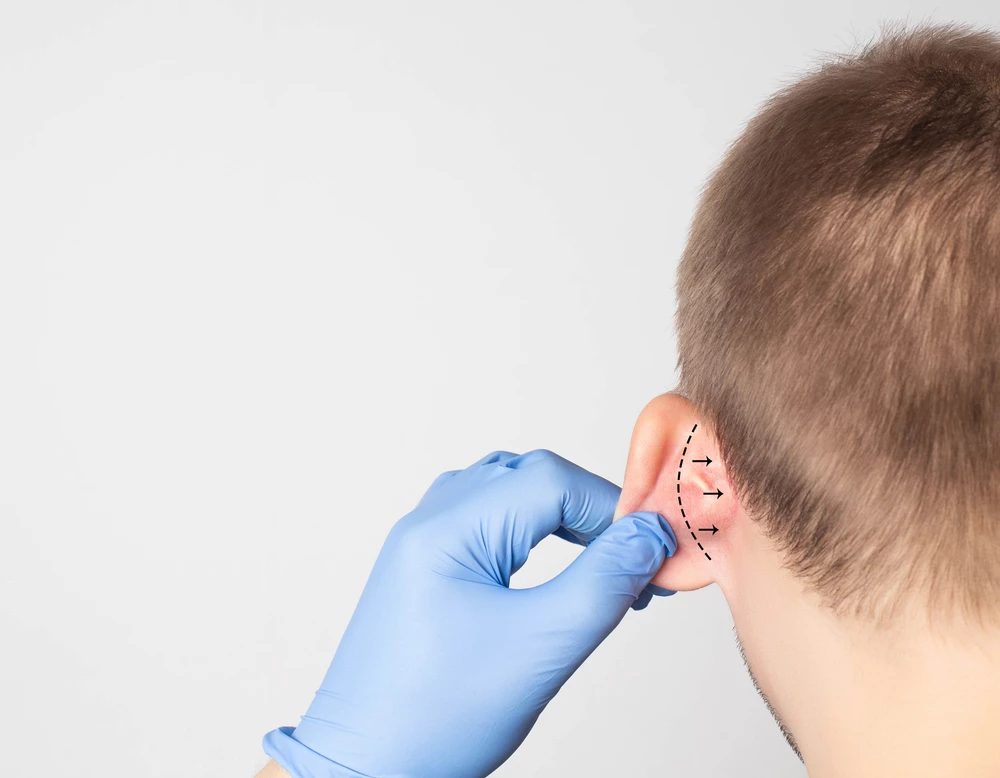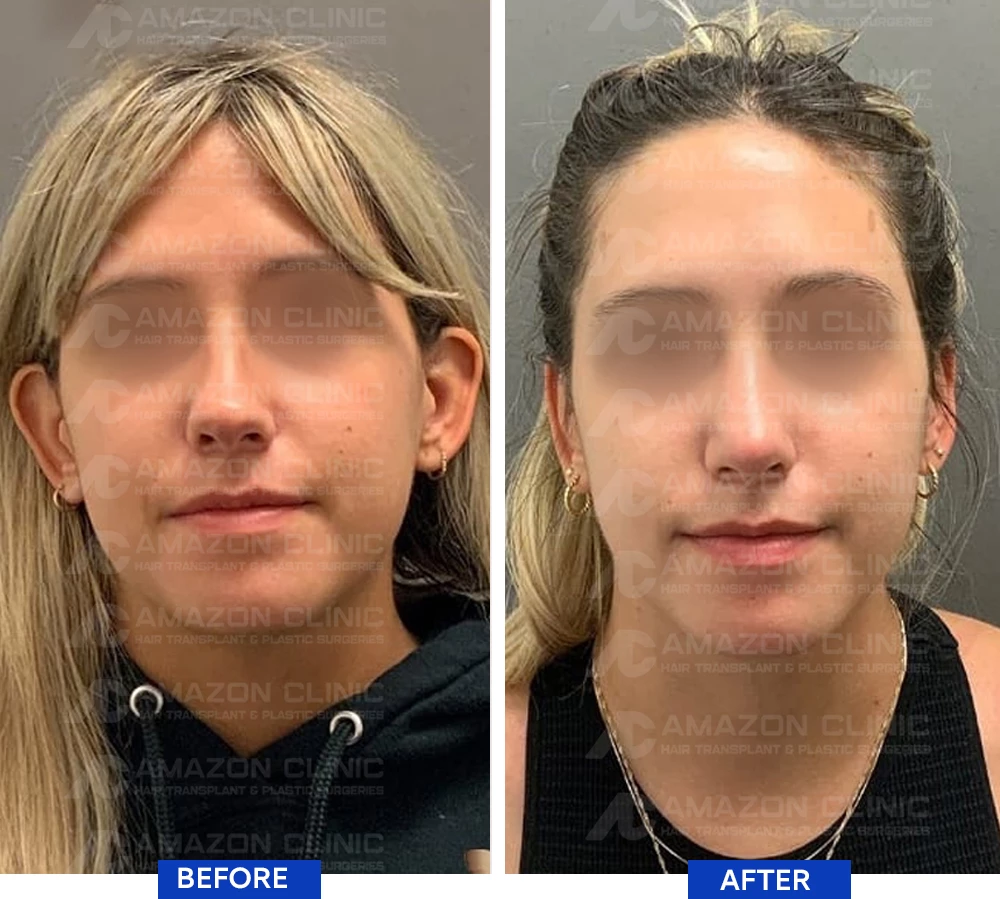Otoplasty, or ear surgery, is a common surgical procedure used to alter the shape of the ear or correct its functional or aesthetic defects. This procedure includes reducing large ears, enlarging small ears, correcting bent ears, or completely reconstructing the ears. Ear surgery is considered a simple and safe surgical procedure, performed externally without the need to enter the body.

Otoplasty is one of the most popular cosmetic surgical procedures, during which the surgeon modifies the shape or size of the ears to help improve the overall appearance of the face. This procedure is characterized by its ease of execution, as the patient can return to their normal life within a few days.
There are several types and forms of Otoplasty surgery, including:
1- Ear Reduction: In this procedure, larger ears are reduced by removing part of the cartilage and skin from the ears.
2- Ear Augmentation: In this procedure, smaller ears are increased in size by implanting cartilage grafts into the ears.
3- Correction of Bent Ears: In this procedure, bent or misshapen ears are corrected by reshaping the cartilage in the ears.
4- Ear Reconstruction: In this procedure, the ears are completely reconstructed in cases where the ears have been lost due to injury or accident.
5- Ear Filling: In this procedure, the ears are filled with injected substances under the skin to give them a fuller appearance.
Some individuals undergo Otoplasty (ear surgery) for several reasons, including:
- Changing the ear shape: A person may want to change the shape of their ears due to congestion, swelling, or deformities in the ear shape.
- Correcting splits: Some people may experience splits in their ears due to injury or accidents, and Otoplasty is sometimes used to correct these splits.
- Correcting congenital deformities: Some individuals may face some congenital deformities in the shape of their ears, and Otoplasty can correct these deformities to improve the appearance of their ears.
- Reducing bulges: The ears may be too large compared to the size of the head, which can be annoying for the person. Otoplasty can reduce the size of the ears and make them appear more proportionate to the head size.
Reasons for undergoing Otoplasty may vary from person to person, and the person should consult with a qualified cosmetic surgeon for a comprehensive evaluation of their case and to determine if Otoplasty is the appropriate option to improve the appearance of their ears.
Yes, ear surgery, known as Otoplasty, can be performed starting at the age of 6, when ear growth has significantly slowed down from the early years of life, and the shape of the ears has become more stable.
Parents who wish to have Otoplasty for their children should be prepared to deal with the necessary recovery period after the surgery.
Some people may consider Otoplasty for cosmetic or medical reasons. The following are people who may consider undergoing Otoplasty:
- Individuals who have congenital ear deformities, such as cupped ears or lop ears.
- Individuals who have ear deformities due to an accident or injury.
- Individuals who have ear protrusion, which may negatively affect the shape of the ears.
- Individuals who are unhappy with the shape or size of their ears.
Otoplasty ear surgery is typically done under local or general anesthesia and takes around two hours. The basic steps of the Otoplasty surgery include:
- Planning: The surgeon evaluates the shape of the ears and identifies any defects that need to be corrected, and the operation is precisely planned.
- Shaping the cartilage: The surgeon shapes the cartilage inside the ear by either cutting or reshaping it.
- Fixing the cartilage: The new cartilage is fixed in place using special sutures or medical staples.
- Closing the incision: The incision made in the skin is closed using special sutures or medical adhesive.
- Sterilization: The wounds are sterilized and covered with bandages to maintain cleanliness and prevent infection.
Before undergoing Otoplasty, some important instructions must be followed to achieve the best possible results and avoid any complications, including:
- Medical tests: Necessary medical tests and laboratory analyses must be performed to determine the health of the circulatory and nervous systems and the overall condition.
- Avoiding certain medications: The treating physician should be informed of all medications taken before surgery, as some medications can affect blood clotting and increase the risk of bleeding during the surgery. These medications include aspirin, non-steroidal anti-inflammatory drugs, vitamins, and dietary supplements.
- Psychological preparation: Psychological preparation is important, and sufficient information about the surgery, its details, and possible effects should be obtained. It is also helpful to talk to people who have undergone the procedure before and inquire about their experiences.
- Quitting smoking: Smoking should be stopped at least two weeks before the surgery, as it affects blood flow and oxygen to the wound, and may delay wound healing and increase the risk of infection.
- Fasting: Food and fluids should be avoided for at least 6 hours before the surgery, as consuming them may cause stomach upset.
- Maintaining ear cleanliness: The ears should be kept clean and properly cleaned before the surgery to reduce the risk of infection.
After undergoing Otoplasty ear, it is important to follow certain instructions to aid in recovery and maintain good results. These instructions include:
- Using bandages: Special bandages should be used to cover the ears for about two weeks. These bandages help to support the ears and maintain their new shape.
- Rest: It is important to rest and avoid any strenuous activity or effort for at least a week after the surgery to prevent swelling, pain, and any exposure to the ears.
- Taking medication: The doctor's instructions regarding pain, swelling, and antibiotics should be followed if necessary.
- Proper cleaning: The surgical area should be kept clean and dry, and swimming and water activities should be avoided for approximately six weeks after the surgery.
- Following up with medical appointments: The recommended medical follow-up appointments should be adhered to, and any necessary tests should be performed to ensure a safe recovery and no complications.
- Maintaining a healthy diet: A healthy diet should be maintained, and fatty, salty, and spicy foods should be avoided as they can affect healing and swelling.
- Abstaining from smoking: Smoking should be avoided completely for about six weeks after the surgery as it can affect the speed of recovery.


